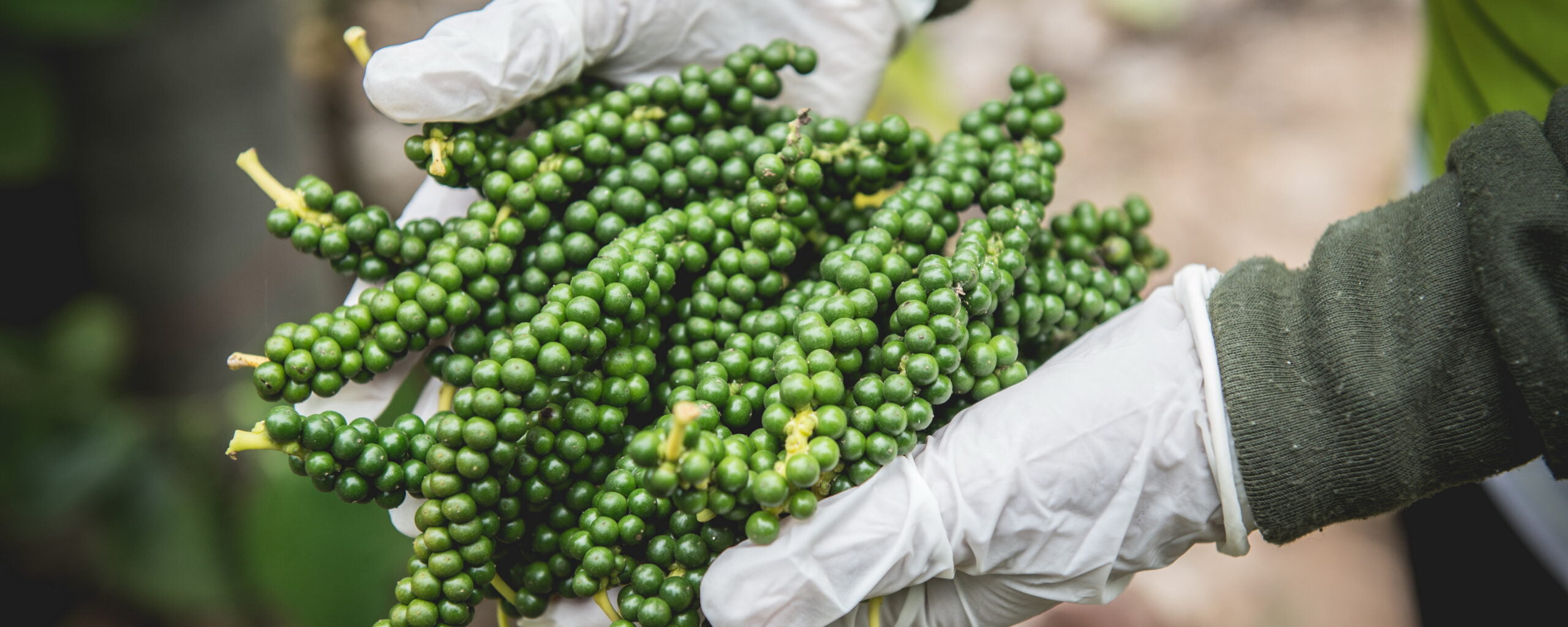
Pepper vines are normally allowed to bear the first crop at the beginning of the wet season in the second year of field planting. Pepper is harvested from March to July in Sarawak.
Harvesting and processing for Black Pepper
Mature green spikes with 1 or 2 berries in the spike starting to yellow are harvested for the preparation of black pepper. In a traditional pepper garden where vines are about 3m high, harvesting of spikes on the upper canopy is done using a ladder.
The fruit spikes are threshed using a manual or motorised thresher and the stalks are separated from the green berries. The berries are then sun dried on mats on top of a raised platform for 4-5 days depending on the intensity and hours of sunshine. The berries are usually spread in thin layer and turned frequently to ensure even drying.
Blanching is sometimes practised by immersing the berries in hot water, of about 90oC, for 2-3 minutes prior to drying. This reduces microbial load, washes off dust particles, and helps in drying pepper faster. Blanched, dried black pepper has a glossy appearance and a better, more uniform colour.
Good sun-dried black pepper should not contain more than 12% moisture. Generally, the conversion rate is about 33% of the green berries, but it can vary from 29 to 36% depending upon the variety and maturity at time of harvest.
Harvesting and processing for White Pepper
Spikes with two or three deep yellow or red berries may be harvested for making white pepper. Under-ripe spikes or immature berries should not be used for this purpose, as the conversion rate will be very low and the quality will be poor. Spikes affected by black berry disease are also not suitable for preparing white pepper. In addition, those fruit spikes picked in the first and last rounds of harvesting show different stages of maturity and do not give a satisfactory product.
The pepper spikes are then put in gunny (jute) bags that are kept immersed in water. After 10-14 days, the bags are taken out and the berries trampled thoroughly and washed several times to remove the softened pericarp, stalks and light berries. Washing is preferably done in rattan baskets that will enable the water and refuse to pass through the small holes of the basket. The resulting clean white peppercorns are sun-dried as in the case of black pepper, but drying is quicker than for black pepper and usually takes about three days. The rate of recovery for white pepper is about 20-25% of the weight of mature berries.
Processing and drying for creamy White Pepper
The newly harvested berries are bagged in gunny sacks which are then soaked in clear running water in a river, in high density polyethylene tanks connected by pipes, in nearby streams or in small man-made dams for 10-14 days to soften the pericarp of the berries. After the soaking, the berries are trampled and washed several times to remove the softened pericarp, stalks and light berries. The resulting peppercorns are then spread in thin layer on mats or polythene sheets to dry in the sun for about three days.
After drying, the peppercorns are sieved using a 4.0 mm plastic sieve to remove the smaller ones. Any wrinkled, dark grey or black peppercorns are removed by hand (at farm level). Any off colour peppercorns are sorted out using a colour sorter at the processing centre. Creamy white pepper is a premium grade pepper that has very uniform creamy white appearance and are even in size with a minimum of 4.0 mm in diameter. It is packed in clean bags for export or retail bottling.
Storage
Pepper may be stored in jute bags or any other suitable containers, after the moisture content has been reduced to 13-14%. The containers should be clean, dry, free from any contamination and odours and preferably new. Re-usable bags (e.g. jute or rice bags) should be cleaned to ensure that they are free from foreign materials which may be detrimental to the produce and/or consumers’ health. Used fertiliser bags are prohibited for storage of pepper. Other food or non-food products (particularly plant protection chemicals) should not be kept in the same room where pepper is stored.
Persons engaged in threshing, sifting, sun drying, etc. should clean their hands and feet with soap and water before they begin to work. Baskets and other containers used in processing and storage should always be kept clean. The premises should be dry and stores should be clean and hygienic. Borders of the drying yard should be protected to keep out birds and domestic animals.
Source:
1. Department Of Agriculture Sarawak
2. ENTIGIS LIFE SARAWAK
